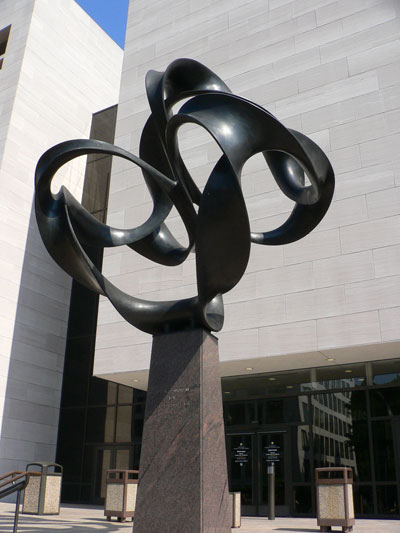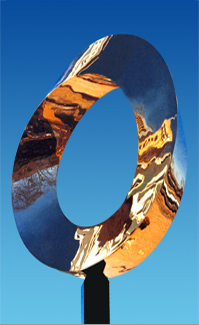Sculpture
The Möbius strip has been featured in many sculptures and fabrications. As astutely pointed out by Clifford Pickover in The Möbius Strip (p. 158), many of these are thickened versions or variants of the 'classic' Möbius strip.
1935+, Max Bill (1908–1994)
One of the first sculptures, if not the first, was by Max Bill, of Switzerland. Starting in the 1930s, he created a variety of 'endless ribbons'. The sculpture is also featured on the Helvetia (Switzerland) 1974 stamp, above.
Max Bill was a hugely influential founder of the Concrete Art movement, not only through his variegated career as a sculptor, painter, and industrial and graphic designer, but also as a prolific writer, scholar, and teacher.
1974, Robert Rathbun Wilson (1914–2000)
Robert Wilson's Möbius Strip is made of 3 x 5-inch pieces of stainless steel which were welded on a tubular form eight feet in diameter. It is almost seven feet in diameter and weighs about 350 pounds. This sculpture was dedicated in May, 1974.
The sculpture isn't the usual rectangular strip with its ends taped together after giving one end a half (180-degree) twist. It's a three-dimensional version of this 'one-sided' surface. The tube's cross section is essentially an equilateral triangle, and this triangle is rotated through 120 degrees along the tube. Wilson used the same Möbius form as the basis for a gleaming bronze sculpture now installed near an entrance to the Science Center at Harvard University in Cambridge, Massachusetts.
Wilson commingled his artistic sensibilities with an impressive career in high-energy physics. As the first director of the Fermi National Accelerator Laboratory (Fermilab) in Illinois, he worked on the Manhattan Project during World War II. He also restored a prairie and a bison herd, built the main building in the style of a French cathedral, and managed the largest particle accelerator! Wilson was certainly an interesting character!
1974. Charles Owen Perry (1929–2011)
A complicated, twisty form stands guard at the entrance to the National Air and Space Museum on the National Mall in Washington, D.C. Created by architect and sculptor Charles Perry and installed in 1976, the sculpture is called Continuum.
According to the artist the piece 'began as an exploration of the Möbius strip, a product of pure mathematics formed by joining two ends of a strip of paper after giving one end a 180-degree twist, thus creating only one edge. The centre of the bronze sculpture symbolizes a black hole, while the edge shows the flow of matter through the centre from positive to negative space and back again in a continuum'.
Perry describes his artwork as a 'Möbius surface of seven saddles, designed to represent the continuum of the universe'.
Other Möbius forms by the same artist include Calligraphic Möbius Helix and Möbius Mace, both at Crystal City, Virginia.
Perry was an American sculptor particularly known for his large-scale public sculptures.
1980, John Robinson (1935–2007)
John Robinson was a British sculptor and co-founder of the Bradshaw Foundation. Robinson first made a name for himself with representational pieces. He also explored various mathematical themes in his series of 'symbolic' sculptures. In 1980, Robinson independently discovered and created several versions of the same three-dimensional Möbius form that had inspired Wilson' 'I prepared 100 equilateral triangles, each with a hole in the middle, and threaded them onto a ring' Robinson recounts. Following the faces around the loop, he saw that he had a surface with three edges and three bands. 'By changing one of the edges to meet another, I found I was left with only one edge and one band' he says. 'It was a magical moment when I realized that I had created 'Eternity'.
Created 1 May 2024. Last Updated 1 May 2024



